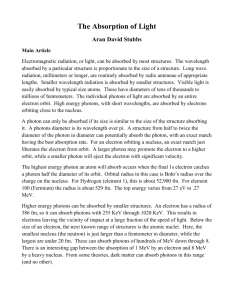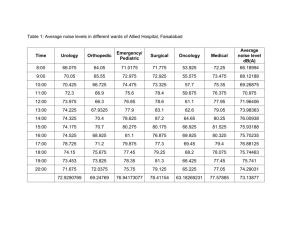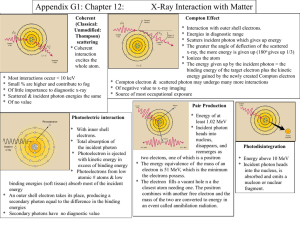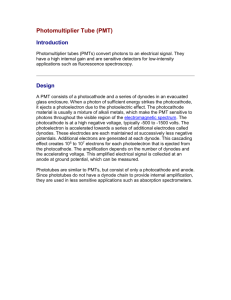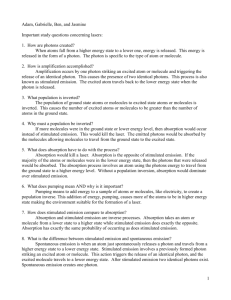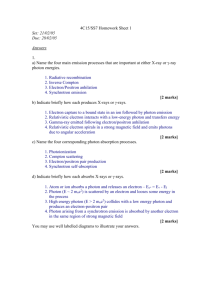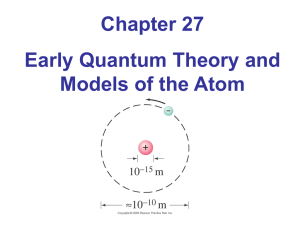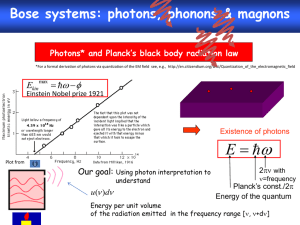photoelectric detectors
advertisement
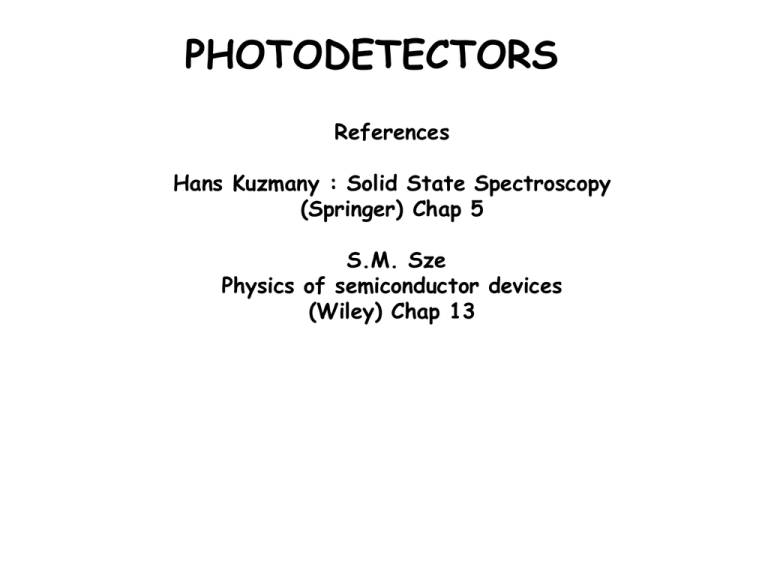
PHOTODETECTORS References Hans Kuzmany : Solid State Spectroscopy (Springer) Chap 5 S.M. Sze Physics of semiconductor devices (Wiley) Chap 13 Detection of Electromagnetic radiation •Signal and Noise •Photomultipliers •Photoelectric Detectors Signal and Noise for photon counting Scattering experiment S= signal N = noise B = background D = dark level Low signal/noise ratio 23/4 = 6.5 Origin of Noise at detector Signal and Noise Scattering Probability = q =1-p Signal = photon absorption Absorption Probability of absorption, i.e. contribution to signal= p For coins p=q=1/2 For photons……. p <<q Low probability event Signal and Noise Signal = photon absorption n incident photons k adsorbed photons Probability of 1 photon absorption = p Probability of no absorption q =1-p Or no contribution to signal Probability absorption of k photons n! P (k ,n , p, q ) p k q n k k ! (n k )! Binomial distribution Signal and Noise n! P (k ,n , p, q ) p k q n k k ! (n k )! For photons……. p <<q Poisson distribution (np )k np P (k ,n ) e k! np = expected value 0.14 n = 200 p = 0.05 k = 10 0.12 0.10 Pnk 0.08 0.06 0.04 k = mean value of k 0.02 (np ) k kP (k ,n )dk e np dk (k 1)! k 0.00 -0.02 0 5 10 15 20 K 25 30 35 40 45 For large n, np k If I have 200 photons every sec, for every second the absorbed photon number might be 7,9,10,15, depending on the probability distribution, but on average I have 10 photons absorbed per sec. So <k> is the average magnitude of the signal The noise intensity is defined as the variance of the Poisson distribution k So the signal is on average 10 By increasing the measuring time (or equivalently increasing the number of incident photons ) the magnitude increases linearly, and the noise increases as square root, so the signal to noise ration gets better as T PHOTOMULTIPLIERS Elements: e- Photocathode Dynodes Anode Operation: • • • • • Photon in Photocathode e- emission e- on dynode Secondary e- emission Current on Anode Photocathode animation http://micro.magnet.fsu.edu/primer/java/digitalimaging/photomultiplier/sideonpmt/index.html Photocathode Material to emit electrons by photoelectric effect Key property: low work function to allow extraction of e- The photon absorption depend on the material Hence the photocathodes are sensible to some part of the light spectrum ne nph Quantum efficiency Radiation sensitivity Ic= current at photocathode P = incident light power Typical 80 mA/W Ic e E P A W Dark current Due to thermal emission of electrons J T M A0T e 2 A0 4mk e 2 h 3 1.2x106 Am-2K -2 20 W KT 1.5 eV 1.6 eV 1.7 eV 1.8 eV 15 e/s*cm2 M = material dependent factor (0.5) T = temperature W = material work function (1.5-3 eV) 10 5 0 200 250 300 T (K) J(T) increases rapidly with T, so photocathode needs to be cooled if you need to observe few e/s 350 400 Dynodes The dynodes work by employing secondary electron emission (SEE) SEE: When a primary beam hits a surface, then it generates electrons that are either emitted either travel into the solid and generate more electrons Secondary Electron Eemission Physical principle: ionization of a solid (atom) by an electron with kinetic energy E0 E0 =[1 106 eV] Each scattering event might generate one or more e- Is I0 Secondary Electron Yield I0 = incident beam current IS = secondary current (I emitted from surface) Secondary Electron Eemission Contributions E0 =[1 106 eV] Ie = elastically scattered eIr = rediffused eIts = true secondary e- e r ts I0 = incident beam current IS = secondary current (I emitted from surface) Collect the current by applying a voltage V so that only e- with EK E = eV arrives at detector The signal is the sum (integral) over the electrons up to the maximum EK Is (E ) S (E 0 , E ) I0 Ep E N (E )d (E ) 0 I0 Usually we are interested in the value of S for a range of energy and to get N(E) we must differentiate the signal dS (E 0 , E ) d N (E ) dE dE N(E) E0 E0 + ΔE Electron Energy (eV) For dynodes all the current originated from secondary emission is used Is I0 The number of dynodes n provides the multiplication factor G (gain) of the photomultiplier G n Typical values = 5, n = 10 G = 510 107 G depends on the voltage because the voltage sets the primary energy of the incident egenerated in the dynode PHOTOELECTRIC DETECTORS Slab of semiconductor between two electrodes Generation of carriers: intrinsic q nn p p cutoff Generation of carriers: extrinsic The cutoff is determined by the energy of donor and acceptor states = mobility n,p = concentration q = charge hc 1.24 ( m) E g E g (eV ) For < c incident radiation is adsorbed Performance detemined by: gain, response time, sensitivity PHOTOELECTRIC DETECTORS Principle of operation n0 = density of carriers generated by a photon flux at t=0 Recombination processes n(t) = density of carriers at time t n (t ) n0e t = carrier lifetime 1/ = recombination rate Steady, uniform photon flux on A=wL P = optical power Total number of photons impinging on the surface/unit time is P/h At steady state, the carrier generation rate is equal to recombination rate Generation rate P G h WLD = quantum efficiency The current due to photon absorbption I p WD WDqnnE P n E I p q h L Defining primary photocurrent as Ip n E gain I ph L tr nE vd The gain of the device depends on carrier lifetime and carrier velocity Carrier Transit time P n h WLD I ph P q h PHOTODIODES Depleted semiconductor High E to separate photogenerated e--h pairs Depletion region small to reduce tr Depletion region large to increase Reverse bias to reduce tr I ph P q h I ph q P / h depends on absorption coefficient R I ph P q h
